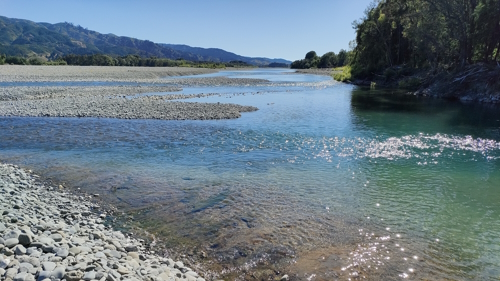
Wairau River
An $8m five-year study has revealed the complex relationship between braided rivers and regional aquifers – and how the way we manage rivers affects vital water storage.
Funded by the Ministry of Business, Innovation & Employment, and led by Lincoln Agritech, the study provides a new understanding of how water flows from braided rivers into regional aquifers.
“We’ve inherited our understanding of how rivers work mainly from research into straight and meandering rivers, with stable riverbeds,” says study author and Lincoln Agritech Hydrologist Scott Wilson. “But braided rivers can change significantly in short periods of time and interact differently with the land and water around them.”
In a paper published in the journal Hydrology and Earth Science Systems titled Conceptualising surface water / groundwater exchange in braided river systems, the authors emphasise the importance of “braidplain aquifers”, and of considering the river system as a whole, rather than just the active channels.
The river system includes not just the wetted river channels but also the associated braidplain gravels, which can be below and/or beside the wetted channels.
Braidplain aquifers are thin deposits of loose gravel that contain less fine material than the surrounding sediments. They are built up during floods, when the strong and fast flow moves riverbed sediments around.
“This braidplain aquifer concept introduces a shallow storage reservoir to the river system, which is distinct from the regional aquifer system,” says Scott. “However, it is crucial in mediating the exchange of water between individual river channels and the regional aquifer.”
In other words, water does not flow directly from the river to the regional aquifer. The river transfers water to the braidplain aquifer, and the braidplain aquifer then transfers water to the regional aquifer.
The relationship between the braidplain and regional aquifer determines how much water flows from one to the other. In some settings the width of the braidplain controls how much water leaks into the regional aquifer, so a narrower braidplain will leak less water.
In other settings the elevation above sea level controls leakage. If you lower the riverbed, you decrease leakage into the regional aquifer.
So, the way we manage rivers can decrease or increase the amount of water recharging our aquifers.
For example, tightly containing the river between narrow banks concentrates the flow of water, increasing its force, particularly during floods. This scours out the braidplain gravel in the active riverbed.
The authors studied three braided rivers: Waikirikiri/Selwyn River in Canterbury; Wairau River in Marlborough; and Ngaruroro River in Hawkes Bay.
In the Wairau and Ngaruroro rivers lowering the riverbed level over time has resulted in permanent loss of water storage.
“Gravel extraction from the [Wairau] river system has dropped the mean bed level by up to 1m within our study reach since the early 1990s,” the authors say.
The Wairau River is the main source of water for the Wairau aquifer, which supplies irrigation, drinking and stock water for Marlborough.
“This work has important implications for understanding how changes in river management (e.g. surface water extraction, bank training and gravel extraction) and morphology may impact groundwater recharge (and potentially flow, temperature attenuation and ecological resilience) under dry conditions,” the authors say.
The research team also included NIWA, the University of Canterbury, Flinders University (Adelaide) and Technische Universität, Dresden, Germany.
See Also
Different approaches to braided river research
Research shows how braided rivers work


